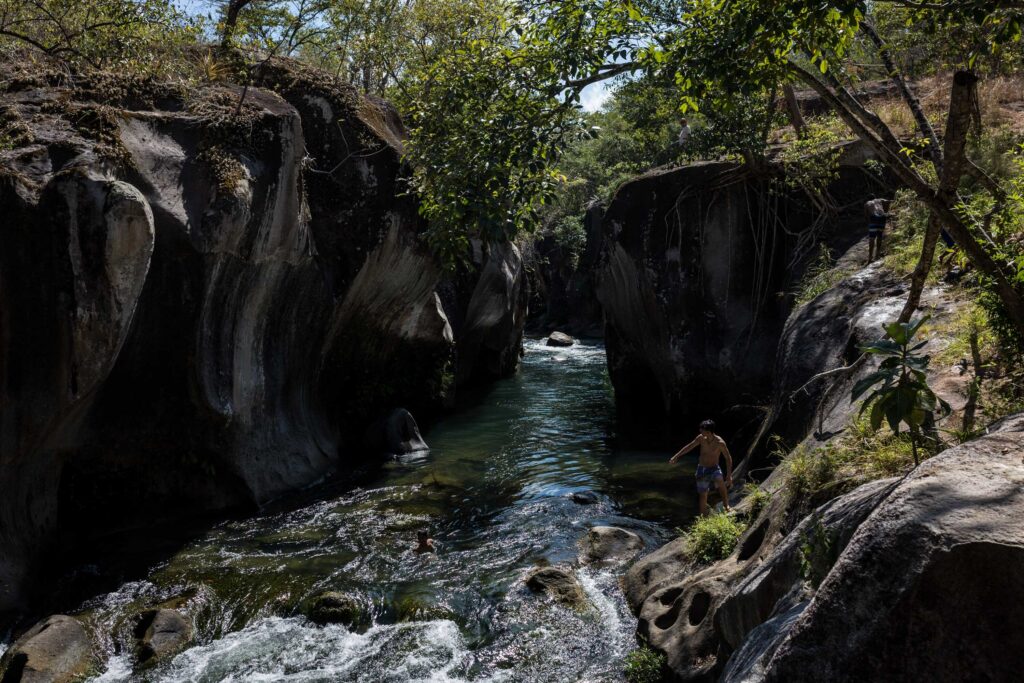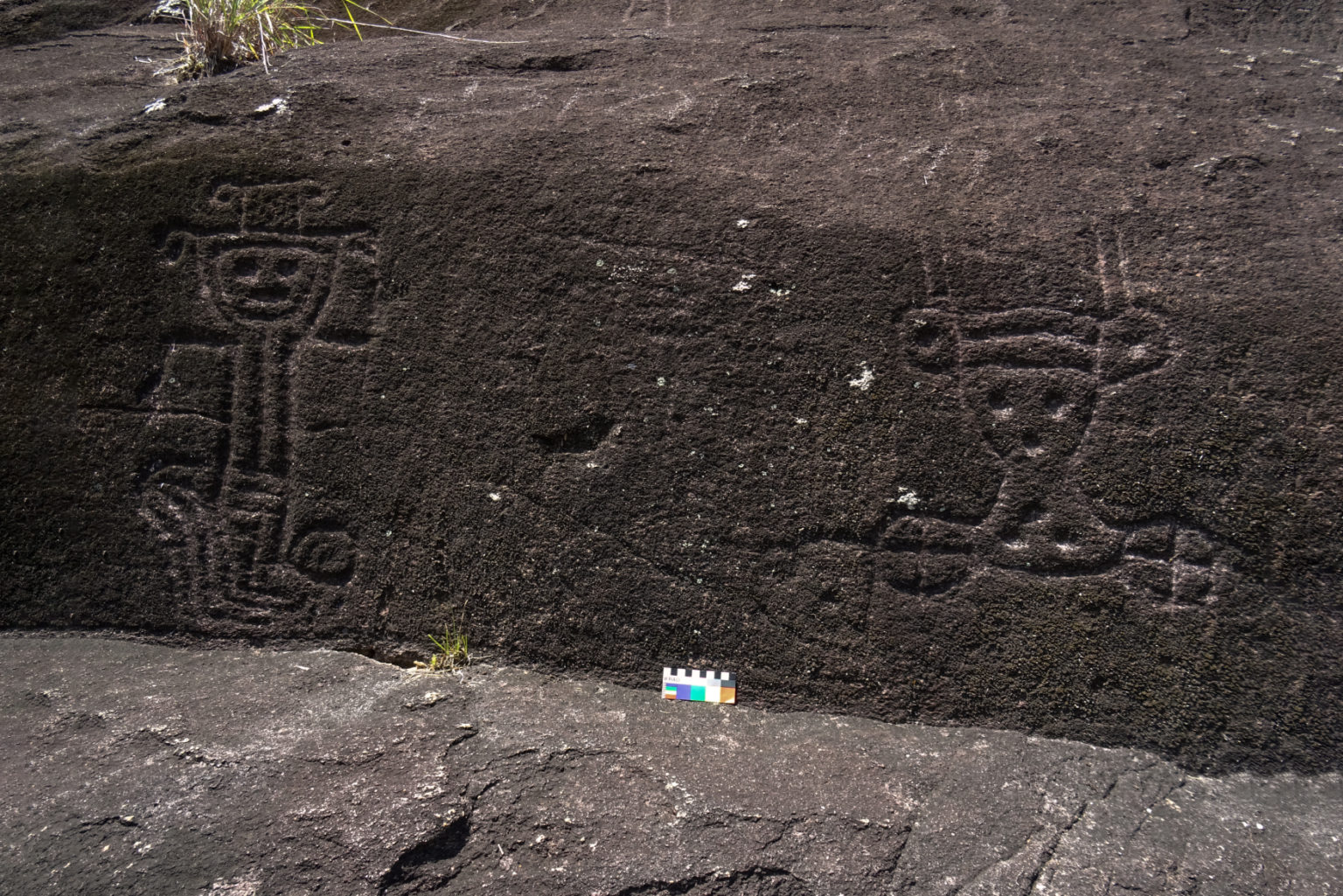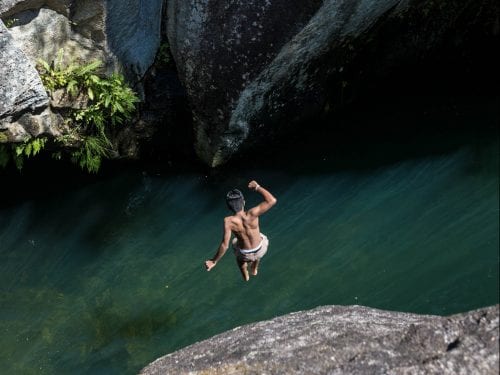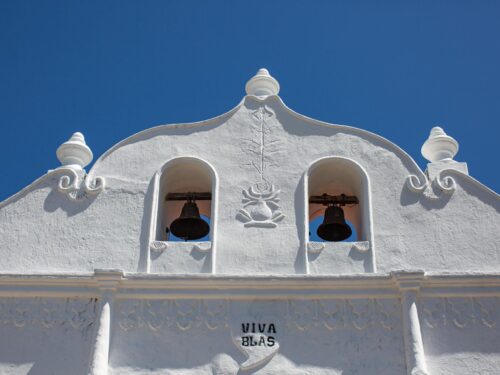
As a child, every Sunday, Berny Mora used to go for a dip in the Colorado River in Curubandé. Since then, he’s been captivated by some drawings carved on the canyon walls that the waters meander through.
At that time, there was very little information about those figures. While the adults limited themselves to repeating to him that those figures were “things from the Indians,” he believed that they were indigenous maps that led to hidden treasures. In time, he understood that they were petroglyphs, ancient images drawn or carved on stones that record human activity in the place.
In 2020, Berny founded the local tourism company Colorado Adventure Tours and, within his services, he came up with the idea to offer tours of several archaeological sites in Curubandé. His logo is a reproduction of one of those petroglyphs.
The interpretation of the logo is the [image] of a shaman. You see some rays of light and you see circles reflecting the water. The circles refer to bodies of water near the place,” he explains.
The first formal study of the petroglyphs of the Curubandé Canyon, also known as La Española, was done in 1898. That year, the director of the National Museum of Costa Rica at the time, Juan Ferraz, found a stone “with very interesting engravings and nearby, “a kind of grotto formed by two large rocks, in one of which notable petroglyphs are preserved.” This is detailed in a report from the Guanacaste Archaeological Project (Spanish acronym: PRAG).
At the site, there are approximately 50 of these drawings throughout the canyon, according to the project’s website.
Between 2018 and 2023, PRAG looked all around the slopes of the volcanoes Rincón de La Vieja, Tenorio, Orosi and Miravalles in order to find and study the petroglyphs that had been written about by different archaeologists since the end of the 19th century, as well as to find new figures.
At La Española, southwest of Rincón de La Vieja, PRAG located 13 of the 50 petroglyphs. In addition, they discovered three more that had not been recorded, according to Priscilla Molina, one of PRAG’s archaeologists.

Access to the Colorado River Canyon is free. Among the rocks there, you can find figures carved more than 1,500 years ago.Photo: César Arroyo Castro
PRAG’s main findings along the Guanacaste Volcanic Mountain Range are available in an exhibition called “Un pasado entre líneas” (A Past Between the Lines) at the Banco Central Museum. The place is open to the public until June of 2025 (see prices and schedules here).
For local guide Mora, contributions from new studies on these petroglyphs allows him to learn more about his community’s history.
“It’s important to know about this topic because this way we preserve history and tell [people] the history that hasn’t been told. Everyone in Guanacaste relates to the Chorotegas. However, [other] indigenous tribes that came before aren’t talked about. These petroglyphs are much older,” he comments.
Art 30 Feet Above the River
“There are snakes, there are corn plants, there are beings with antennas, there are masks,” Mora says, describing the petroglyphs. During the tour he gives of the canyon, the guide shows up to 20 of these figures.
These petroglyphs were possibly used for rituals by inhabitants of the area, done between 300 AD and 800 AD, according to PRAG’s analysis.
“[In these figures,] we didn’t see iconographic relationships with petroglyphs from other regions, which makes us think that there was no pilgrimage process [for those who carved the petroglyphs]. Possibly they were made by a group that lived nearby for ritual purposes,” explains the archaeologist.
The results of PRAG’s research determined that the ancestors probably carved the canyon’s figures with hammers and stone chisels.
The height above the Colorado River at which the petroglyphs were made caught Molina’s attention. The archaeologist is evaluating the possibility that the ancestors made them while hanging from the top of the canyon wall.
They had to have used some methodology to be hanging in certain parts,” Molina believes.
Another of the archaeologist’s hypotheses is that they made holes in the rock to insert vines and in that way created a kind of scaffolding that would allow them to climb.
Mora believes that the ancestors climbed the canyon rock to make the drawings. The guide estimates that “they may be more than ten meters (32 feet) above the river.”
“They had an awful lot of practice, an awful lot of balance and talent for climbing. [The canyon] is quite a porous rock so it’s a rock that’s like sandpaper,” explains Mora.
Vandalized Petroglyphs
Access to the canyon’s petroglyphs is public. Anyone visiting the Colorado River can see them. Molina believes that easy access has also translated into vandalism.
There’s a wall that is completely marked up, just like on the petroglyph on the front wall [of the canyon]. If you cross the river, there’s a petroglyph on one of the walls that is barely visible and [people] also carved things there,” says the archaeologist. The damage is irreversible.
In 2015, a report from the National Museum detailed the main damages that these rock art pieces have suffered.
“Engravings made using blades, pointed stones or other sharp instruments, either to record their “visit” or to “imitate” pre-Columbian designs. This type [of] damage or vandalism causes “a false history” in the eyes of tourists who are not specialists in determining the difference between original designs and those made currently,” the report says.
Mora thinks many of the figures were vandalized out of ignorance.
“People have the habit of making them stand out, using stones trying to redraw over them. People wanting to do something good do something bad, but obviously this is going to cause an alteration in the petroglyph,” he comments.







Comments